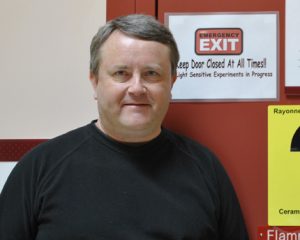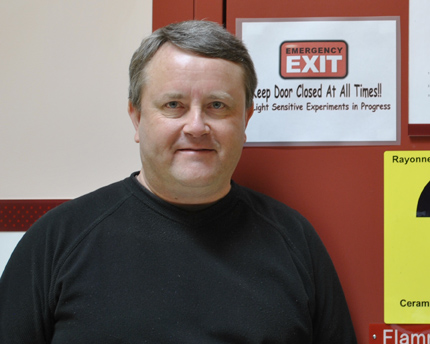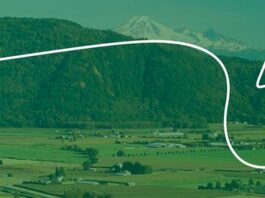By Nick Ubels (Online Editor) – Email
 Can a single grain of sand – taken from a river bank and then zapped with a laser beam – be used to determine the age of its surrounding geological features?
Can a single grain of sand – taken from a river bank and then zapped with a laser beam – be used to determine the age of its surrounding geological features?
The answer is a resounding yes, according to Dr. Olav Lian, the UFV geography professor who led the January 26 presentation “Understanding the timing and nature of climatically-driven landscape change in Western Canada by reading the landscape’s solar birth certificate.”
But what is luminescence dating, exactly?
“Simply put,” said Lian, “it’s a technique that is used to determine the amount of time that’s elapsed since mineral grains… were exposed to sunlight or sufficient heat.”
The testing procedure involves placing up to one hundred individual samples on an aluminium disc no more than one centimetre in diameter, then directing a laser beam toward the quartz or sand particles which will glow violet in response.
“The older the sample [is], the more luminescence it [gives] out,” he said.
Lian, who has dedicated his life’s work to the advancement of this technique, is the director of UFV’s Luminescence Dating Laboratory, the only one of its kind in Western Canada.
This region provides Lian and his team with a variety of opportunities to use this technique to determine historical climate patterns and predict future changes.
“Anyone who’s driven up through the Fraser and Thompson Valleys has probably noticed these… terraces formed by the Fraser River,” said Lian. “The environment is incredibly sensitive. It’s in equilibrium with the present climate. The question is: if the climate gets wetter, what will happen to these very fragile landfalls? Will they all get washed into the Fraser? What will happen to the ranch land, to the native land up there?”
Luminescence dating allows researchers to better understand the effect of climate change on the landscape by determining when geological features began forming, when they stopped, and when they were last unstable.
“What we’re picking up is the bigger events,” said Lian, maintaining that this technique is best used to trace long term shifts in climate.
While he is doubtful whether much can be done to prevent large-scale changes to our physical environment caused by naturally-occurring climate cycles, Lian believes that we can better prepare for these shifts the more we know about their historical precedents.
“The… problem is to see this coming far enough ahead so we can do something… to try to slow down the shift,” he said. “Big shifts in climate, you really can’t stop; you can only adapt to them.”
Lian got his start in luminescence dating during the fourth year of his Bachelor of Science degree at SFU under the direction of Dr. David Huntley, a pioneer in the field who offered him a summer position as a research assistant in 1985.
“I thought, ‘Oh great, I’ll get a new car and all that stuff,’” he said. “That was 26 years ago and here I am talking to you guys.”
Luminescence dating technology has come a long way since its early days, when the procedure required the use of a $30,000 argon laser beam.
“Dave Huntley looked to fund his own laser and it just so happens if you go to a rock show, they use these things in different colours,” said Lian. “And he actually found a rock band that wasn’t doing very well, they were going out of business and we bought one for half price. And that was the first laser.”
These days, Lian said that he uses a much cheaper semi-conductor laser beam, “just like my laser pointer here.”
According to Lian, academic interest in luminescence dating is growing at a tremendous rate.
“We turn down a lot of work,” he explained. “There’s so much interest in this method that I get emails, probably one or two a week, a lot of them with money attached and we’re saying, ‘No, we can’t take that on.’”
Currently, Lian is supervising or co-supervising nine Master’s of Science and Doctorate students from SFU and the University of Victoria who are conducting research connected to his UFV laboratory.
The 2010/2011 University Lecture Series will continue with a presentation by Dr. Peter Raabe of UFV’s Philosophy Department entitled, “Change your brain, change your mind?” in which he will consider mental illness through a philosophical lens. Raabe’s lecture will take place on Wednesday, February 23 at 4 p.m. in Room B121 of UFV’s Abbotsford campus.




